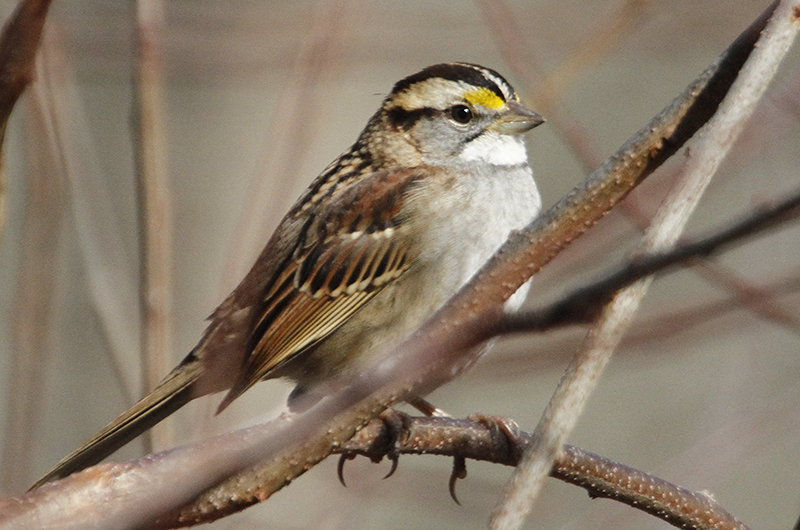Red-breasted nuthatches are just about everyone’s favorite. What is not to like about these small but energetic birds that frequent our feeders and woodlands in some winters. We call them red-nuts for convenience, but there are only a few pairs nesting in the state forest and other larger pine woodlands. White-breasted nuthatches are their more abundant cousins that are common year-round at feeders and in our woodlands.
Irruptive describes the winter distribution of the red-breasted nuthatch. Most of them breed in the northern forests of Canada and some years they migrant south early in the fall. When conifer seeds are abundant in the north they stay up there, migrating south only when their food runs out.
The annual Christmas Bird Count data reflects their irruptive winter distribution. None of them were seen on the 2017 count and only two were seen on the 2013 count. This contrasts to the 109 seen on last year’s count, while 296 were spotted on the 2012 count.
How many red-nuts will we find on this year’s Christmas Bird Count on Saturday Jan. 4? They have been scarce this fall, but recent sightings suggest they are coming. Gus Ben David spotted a few in early December in a large woodland off North Road while Lanny McDowell spotted his first of the season on Dec. 22. Sande Weinstein reports them in her yard as does Ira Certner.
Bird Sightings
Eastern bluebirds are another favored species, as anyone who has seen their electric blue backs shining in the direct sunshine can understand. They typically are in smallish flocks of up to a dozen birds, but occasionally they gather into larger flocks. Matt Pelikan watched a flock of 40 or so eastern bluebirds in the plant nursery section of Muskoday Farm in Katama on Dec. 22. That same day, Sharon Simonin spotted a flock of them in the junipers on Sunset Hill in Oak Bluffs, and Myron Garfinkle spotted a flock of them along Scrubby Neck Road.
In the winter, robins often hang out with bluebirds, as they both tend to eat berries. Larger flocks help them find small patches of food while providing more eyes to look out for marauding predators. I have been seeing several robins consuming the remnant dried crabapples on a tree in my Vineyard Haven yard.
David Stanwood saw two eastern catbirds actively feeding on rose hips in his yard on Dec. 19. Doyle Bunch also has two visiting his yard. Most of us do not have catbirds at this time of the year as they prefer to forage in dense shrubs.
Other thicket birds include hermit thrushes and white-throated sparrows. Michael Ditchfield spotted a hermit thrush in Dark Woods on Dec. 20. Lsten for their distinctive low “chuck” call. White-throated sparrows are much more common and can be seen at many bird feeders — one showed up at our feeder on Dec. 22.
On Dec. 22, Scotty Goldin reports the large flock of European starlings that hang out in Katama. This species is not particularly popular because they are not native and they aggressively displace other cavity nesting species. But their black winter plumage with many small yellow spots is quite attractive.
News is scarce this week on the waterbird front. Lanny McDowell spotted mallard, northern pintail, and green-winged teal in the pond at the headquarters of the state forest on Dec. 22. John Nelson spotted 29 black ducks at Sarson’s Island at low tide on Dec. 22. Why do they concentrate there at low tide when they are decidedly less common at other tides? And Jeff Bernier spotted a pied-billed grebe in Menemsha on Dec. 21.
Martha Moore spotted two adult bald eagles on the osprey pole at Long Point on Dec. 21. Myron Garfinkle spotted another eagle along the West Tisbury-Edgartown Road. And Gus Ben David regularly has two immature eagles that frequently circle over his yard, but they have not landed to join the 28 turkey vultures that visit his yard daily. He also has a pair of ravens that circle over his yard almost every day.
Gus Ben David also reports a single yellow-rumped warbler that comes to his feeders almost every day. But only one shows up, unusual for this gregarious species.
Sheri Caseau’s family found a gray phase screech owl standing in the middle of the Edgartown-Vineyard Haven Road. Miraculously, it did not get run over by the many speeding cars. They rescued it and brought it to Gus Ben David, where it is doing well and will soon be released. It is only the fifth or sixth gray phase screech he has received, as most of our screeches are red phase.
Lastly, as I was filling my feeders on one of the recent cold mornings I heard a black-capped chickadee singing its two-note whistled “feee-beee” song. Carolina wrens are the only other species which I have heard singing in December.
Please remember that there will be 60 or more birders ranging over the Island on Saturday, Jan. 4, whether the weather is fair or foul. We appreciate your consideration for these motley binocular and camera carrying field teams. Happy New Year! Our winter residents are mostly here, but migrants will still arrive. Please report your sightings to birds@mvgazette.com.
Robert Culbert is an ecological consultant with Nature Watch LLC living in Vineyard Haven.






Comments
Comment policy »